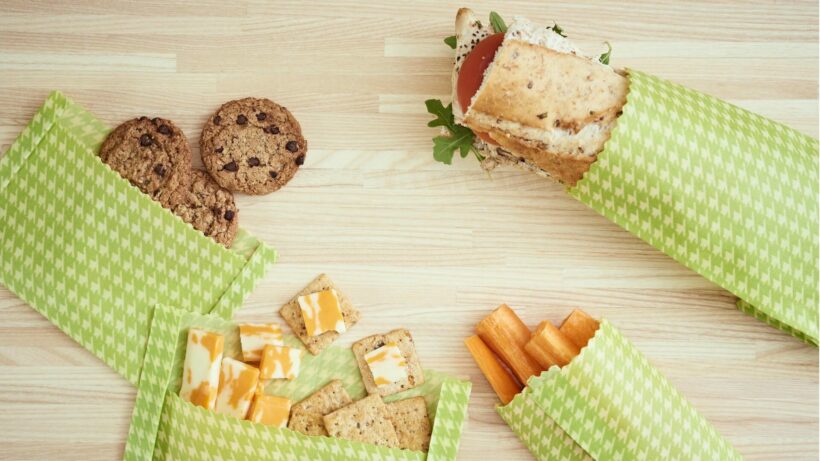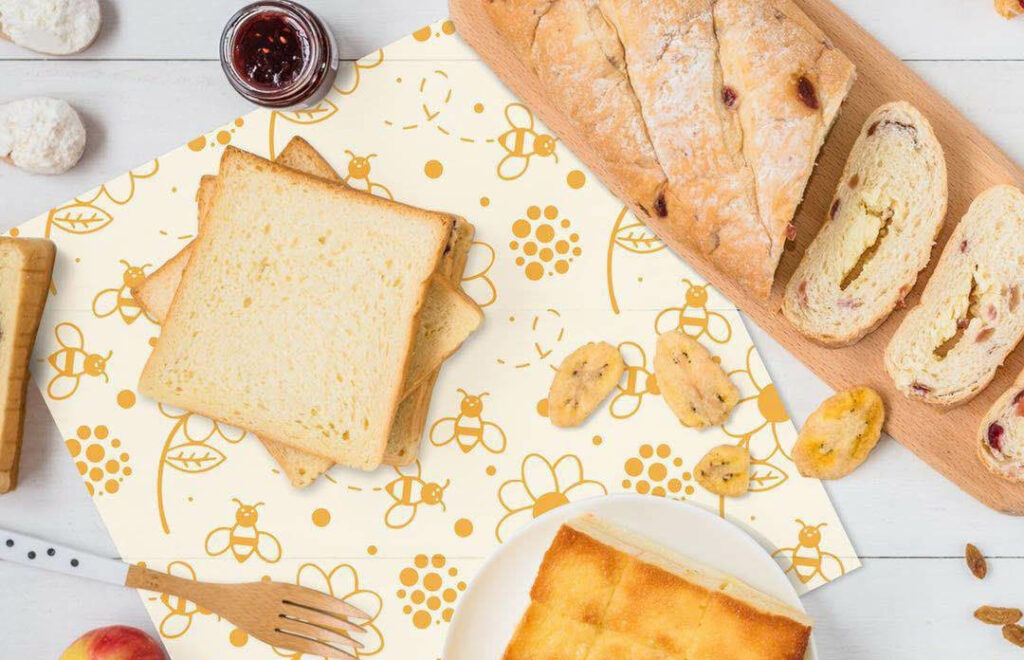A true ally for a zero waste routine, the bee wrap is causing a stir among food packaging today. It is not only popular for the aesthetics of its patterns but also for its reusable and ecological aspect. what is a bee wrap ? How to use it? How to preserve its durability? Here is something to answer your questions on the subject.
The Bee Wrap: what is it?
Le bee wrap takes the form of a natural fabric coated with beeswax and intended for the packaging of food of various kinds. Its reusable nature allows it to reduce daily household waste. This accessory is therefore an ecological alternative to cling film in plastic and aluminum foil.
You will find the fabric soaked in beeswax in different designs to suit your tastes. You can use it for storage of fruits, vegetables or preserves started. If the composition varies between manufacturers, bee wrap packaging, found in many zero waste stores, is generally formulated with organic ingredients such as:
- beeswax or vegetable wax: it promotes the adhesion of the packaging to the containers (salad bowls, glass jars, plates, etc.)
- jojoba or sunflower oil: it helps preserve the freshness and hydration of food
- pine resin: it facilitates the malleability of the fabric and its adhesive power
- cotton from organic farming
It should be noted that the beeswax fabric adapts to any container due to its thermoformable property.
The bee wrap: How to use it?
Reusable food packaging offers the simplest instructions for use as explained in this short video:
Which method for a first use?
If you get your packaging as a pack, it is possible for the fabrics to stick together. In this case, it is enough to take off them in a delicate way. You will also feel the material of the product quite rigid at first. Remember to unfold the packaging and then crumple it for a few seconds. The warmth of your hands will soften the fabric and make it much more malleable. Your accessory is therefore ready for packaging food or containers.
How to store food in bee wrap?
The fabric coated with beeswax is the ideal ally for swaddling and storage of leftover fruits and vegetables, sandwiches… To do this, be sure to do it in the following way:cons
- place the food in the center of the organic food packaging
- fold the fabric over itself
- for better adhesion, exert light pressure with the palms of the hands to release sufficient heat
All you have to do is store your food in the fridge or freezer.
How to cover a bowl in bee wrap?
Eco-friendly food packaging is also intended to wrap containers for refrigeration storage. In this case, just follow a very simple procedure:
- spread the beeswax cloth on a table
- place the container on it
- then cover the container with your packaging
- apply light pressure with your fingers to adapt the fabric to the shape of the container
After use, you only have to clean your packaging for future use.
What are the benefits of using a bee wrap?
Beeswax food packaging appeals to many users from both an ecological and health point of view. In concrete terms, switching to this accessory has several advantages:
- beeswax fabric retains no odor or taste
- beeswax makes the wrap waterproof while giving it an antibacterial function
- the organic packaging can be used for about 12 months unlike classic single-use models
- it makes it easy to transport food to the office or school
- it is free of endocrine disruptors like BPA or phthalates that are commonly found in plastic or aluminum food packaging
- beeswax fabric is fully recyclable, biodegradable and compostable, so better for the environment
- the beeswax fabric is completely natural, it does not release any toxic material likely to migrate into food
- it is suitable for storing food in the freezer, refrigerator or at room temperature
- the wax of the product gives it a thermoformable property, so it adapts to the shape of any food or container
- it is easily maintained with cold water and soap
Finally, the beeswax wrap is more economical insofar as you will have to use it a hundred times.
How to clean the bee wrap?
It is recommended to maintain the organic food packaging using a mild ecological soap and cold water. The procedure to follow generally takes only a few steps:
- run the wax fabric under cold water
- rub gently using your hands or a soft sponge and soap
- for stubborn stains, let the product soak in cold water for a few minutes
- then wipe with a clean cloth
- hang the fabric in the open air with a clothespin
- fold the packaging then store it in its original box once dry
In order to preserve the performance of your ecological cling film, do not clean it with hot water or put it in the dishwasher. This action risks melting the wax, thus rendering the packaging unusable.
What are the precautions for using a bee wrap?
To enjoy your ecological cling film over time, be sure not to put it in the microwave, dishwasher or oven. Also, it is not recommended to wrap meat or fish directly in bee wrap. As an alternative, put the meat in a Tupperware® or a glass jar covered with organic cling film.
On the other hand, it will be necessary to take into account equally important recommendations to ensure the viability of your packaging:
- avoid cutting food on the wax-coated fabric at the risk of perforating it
- contact with heat sources is prohibited
- be careful to dry the package flat
- beeswax cling film is not suitable for wrapping plastic containers unlike those made of ceramic, glass or metal
- regularly use your natural food film at the risk that the wax loses
In addition, it is advisable to store the product at room temperature in a clean and dry environment.
How to restore your bee wrap?
Over time, your reusable cling film is likely to lose effectiveness as the wax gradually fades away. In this case, you can give the fabric a new look in a few minutes:
- first clean your beeswax packaging to remove any dirt
- look for beeswax from bulk grocery stores or an organic store
- Start by preheating the oven to 80°C.
- spread the organic food film on a sheet of parchment paper then disperse beeswax on it
- put everything in the oven for 5 minutes at most
- turn off the oven and let the fabric cool
- take out the packaging then crumple it in order to distribute the wax evenly
You will then be able to enjoy your natural food film again over time. Note, however, that at the end of the life of the fabric, the aforementioned method may prove to be inconclusive. Remember to compost your packaging once cut into strips.
What size for a bee wrap?
Depending on whether you want to cover a small food or a large container, the dimensions of the product will have to vary widely. In general, these packages are offered in 3 different formats:
- the small size: it is appropriate for food or small containers (oranges, lemons, onions, cans, mugs, glass jars, etc.)
- the medium size: you can wrap fruits, vegetables, bread or even larger bowls in it
- the large size: it is suitable for packing salad bowls, pie dishes or large fruits such as melon
To deal with the unexpected, do not hesitate to get a pack containing the 3 formats.
What criteria for choosing a bee wrap?
Victim of its popularity, the bee wrap is now marketed in a variety of versions that are sometimes unhealthy or ecological. It is therefore up to the consumer to pay attention to certain factors in order to make the best choice. Among the criteria to be taken into account are:
- the fabric of the product: opt for packaging made from organic cotton with OEKO-TEX or GOTS certification
- the quality of beeswax: organic sealing wax is the ideal option for the environment; please bet on a French wax because it is free of pesticide residues
- the type of resin: French pine resin is more widespread relative to Dammar resin, mainly from New Zealand or Australia. To limit the risk of allergy, make sure that the pine resin is free of Delta-3 Carene
So take the time to read the ingredients that make up your reusable beeswax wrap. In case you lack information, do not hesitate to inquire with a zero waste shop is also their advantage
You are now better informed about the nature of a bee wrap and how to use it on a daily basis. It should be noted that this accessory combines practicality and preservation of environmental resources. Finally, note that you have the possibility of making your own beeswax packaging from ingredients easily accessible at the organic store.




